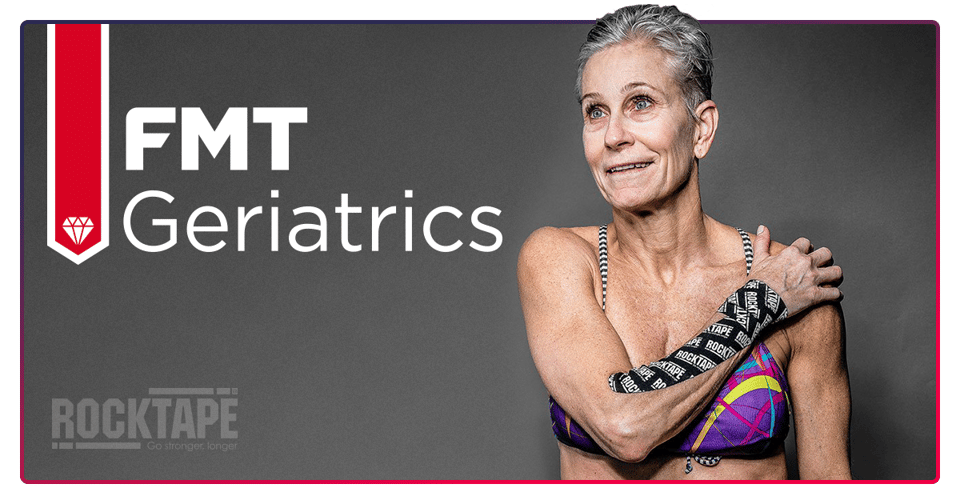This course is 6 hours in length and a 30 Question multiple choice quiz will be required after completing the course to receive your CEU certificate. A 70% test score is required to pass and receive CEUs. The quiz can be open book and unlimited attempts on the quiz are allowed.
FMT Geriatrics - Kinesiology Taping

Description
Until now, choices were limited if you wanted to learn how to use kinesiology tape with special patient populations like the elderly or children.
You don’t have to memorize percentages of stretch or direction of tape in order to get safe, effective results when taping special populations.
FMT Geriatrics introduces the concept of functional kinesiology taping methods with focus on special considerations for the geriatric population. In this course, students will practice musculoskeletal screening assessment, taping and re-assessment of geriatric specific conditions including total joint replacement, stroke, balance disorders, neurologic dysfunctions, fall risk and osteoarthritis. Additionally, FMT Geriatrics includes a review of current literature that supports theories of kinesiology taping for improvement of performance, rehabilitation, edema/swelling management, neurologic dysfunction, management of scars and postural conditioning. These courses are intended for health professionals who have taken FMT Basic.
Functional Movement Training (FMT) courses are taught by industry leading experts in movement assessment, performance and rehabilitation. CEUs may be offered for DC, ATC, PT, LMTs, LAc, OTs and personal trainers. If your profession & state is unavailable, we do not currently offer CEUs – however, we are continually adding additional licenses.
Note: Tools are not provided with this course.
Learning Objectives
- Define and discuss geriatric population needs
- Define, discuss and consider concepts of myofascial chains as an approach to treatment for a multitude of aging conditions
- Discuss and communicate the physiological effects of kinesiology taping
- Critically analyze considerations of taping applications based on current research
- Compare and contrast functional taping applications for geriatric related postural, orthopedic, inflammatory and neurological conditions
- Justify fascial taping applications for applications of postural, orthopedic, inflammatory and neurological conditions
Course Procedure
Course Content
| FMT Geriatric Taping | Module |
Milica McDowell DPT

Dr. Milica McDowell is the Senior Director of Medical for RockTape, her background is as an orthopedic physical therapist. She has worked with athletes from high school kids to the weekend warrior to pros from the NFL, NHL, MLB, XGames, Pro rodeo, triathlon, and the performing arts. Dr. McDowell has a background in team sports, yoga, Pilates, CrossFit, clinical bike fitting and rehab for ultra-endurance athletes. Dr. McDowell was a faculty member at Montana State University in the Health and Human Performance program from 2008-2019 and is the founder of Epic Fitness Center, Bluebird Medical Supply and Clearwater Physical Therapy. Dr. McDowell has two Bachelors’ Degrees from Montana State University, a Master’s Degree from University of Colorado and Doctorate in Physical Therapy from Idaho State University. She has lectured both nationally and internationally, is a published author, textbook editor and has a United States Patent. In her free time, she enjoys triathlon, alpine and skate skiing and exploring Montana’s outdoors with her husband, family and poodle-mix dogs.
Hour One
Who is the geriatric population and how are they defined? (Ch 1)
Introduction of Taping History (Ch 2)
- Types of taping, rigid vs dynamic tape
- Kinesiology taping and its popularity
- Kinesiology tape – features and characteristics
- Tape application, skin preparation techniques
- Reducing risks involved in kinesiology taping
- Past and future taping techniques, trends and movements
Skin Anatomy/Physiology and Tape Mechanisms (Ch 3)
- Skin-brain connection
- Sensory system, discussion of hair follicles and skin receptors
- Cortical Homunculus Review
Effects and Benefits of Kinesiology Taping (Ch 4)
- Pain and how Kinesiology tape improves this condition
- Decompression and Mechanical effects of kinesiology tape
- Neurosensory communications to the brain via skin stimulation
Hour Two Pain Mitigation Effect of Tape (Ch 4)
- Pain Gate Theory
- Neuromatrix Model
- Biopsychosocial Model of Pain (BPS)
- Science Literature Review
Decompression Effect of Tape (Ch 6)
- Looking under the skin with MSK Ultrasound
- Science Literature Review
Neurosensory Input Effect of Tape (Ch 7)
- Importance of brain’s role in movement
- Effects of Tape on Balance, Tactile Acuity
- Science Literature Review
- Does direction of tape and amount of tape stretch matter
Kinesiology Tape Theory Questions (Ch 8)
- Qualities of Kinesiology Tape
- Science Literature Review
- Does direction of tape and amount of tape stretch matter
Kinesiology Taping Basic Technique Considerations (Ch 9)
- General taping application rules
- Indications/Contraindications
- Negotiables and non-negotiables for technique
Hour Three Geriatric Conditions (Ch 10)
- Joint Stability overview of patient presentation and tape indications
- Joint Replacement overview of patient presentation and tape indications
- Osteoarthritis overview of patient presentation and tape indications
- Stroke overview of patient presentation and tape indications
- Posture overview of patient presentation and tape indications
- Fall Prevention overview of patient presentation and tape indications
Joint Stability Taping Strategies (Ch 11)
- Goals of Taping Strategy for Joint Stability
- Ankle Tape practical lab experience, instructor feedback
- Knee Tape practical lab experience, instructor feedback
- Shoulder Tape practical lab experience, instructor feedback
- Wrist Tape practical lab experience, instructor feedback
Hour Four Joint Replacement Taping Strategies (Ch 12)
- Goals of Taping Strategy for Joint Replacement
- Fluid Dynamics, Decompression effect of tape
- Total Knee Replacement Tape techniques lab experience, instructor feedback
- 1 week post-op, 1 month post-op
- Total Hip Replacement
- Tape techniques lab experience, instructor feedback
- 1 week post-op, 1 month post-op
Osteoarthritis Taping Strategies (Ch 13)
- Goals of Taping Strategy for OA
- Knee Tape techniques lab experience, instructor feedback
- Hip Tape techniques lab experience, instructor feedback
- SI Joint Tape techniques lab experience, instructor feedback
Hour Five Stroke Taping Strategies (Ch 14)
- Goals of Taping Strategy for Stroke
- Depressed Humeral Head Tape techniques lab experience, instructor feedback
- Hand Opening Tape techniques lab experience, instructor feedback
- Upper Extremity Helix Tape techniques lab experience, instructor feedback
- Lower Extermity Helix Tape techniques lab experience, instructor feedback
- Drop Foot Tape techniques lab experience, instructor feedback
Posture Taping Strategies (Ch 15)
- Goals of Taping Strategy for Postural Support
- Forward Head Tape techniques lab experience, instructor feedback
- Forward Shoulder Tape techniques lab experience, instructor feedback
- Dowager’s Hump Tape techniques lab experience, instructor feedback
- Pelvic Tilt Tape techniques lab experience, instructor feedback
Hour Six Fall Prevention Taping Strategies (Ch 16)
- Goals of Taping Strategy for Fall Prevention
- Afferent feedback of tape for neurosensory support
- Biomechanical Joint by Joint considerations
- Low Back Tape techniques lab experience, instructor feedback
- Rectus Abdominus Tape techniques lab experience, instructor feedback
- LE Helix Tape techniques lab experience, instructor feedback
- Posterior Fascial Chain Tape techniques lab experience, instructor feedback
PT/PTA
AK, AZ, DE, GA, HI, ID, IN, MI, MS, MO, MT, NC, ND, PA, SC, RI, TN, VA - FMT Geriatrics meets continuing education requirements for these State Physical Therapy Boards by virtue of ATPTA KY (FMT Geriatrics 6 Category 1 contact hours), Approval Number 279-APTAKY-2024.
AL, CO, CT, IA, MA, ME, MN, NH, OR, SD, UT, WA, WY – FMT Geriatrics meets continuing education requirements for these State Physical Therapy Boards
DC/IL – FMT Geriatrics (6 contact hours) meets continuing education requirements for these State Physical Therapy Boards by virtue of a National University of Health Sciences approval. NUHS is recognized by the Secretary of States Department of Education.
KY - FMT Geriatrics has been approved by the APTA Kentucky, A Chapter of the American Physical Therapy Association, for 6 Category 1 contact hour(s). Approval number: 279-APTAKY-2024
LMT
FMT Geriatrics (6 CEs) is approved (#179) by the National Certification Board for Therapeutic Massage & Bodywork (NCBTMB) as a continuing education Approved Provider.
OT
FMT Geriatrics meets continuing education requirements for AR, HI, ID, MA, ME, MI, NE, ND, SC, TX, VA, WI OT Boards.